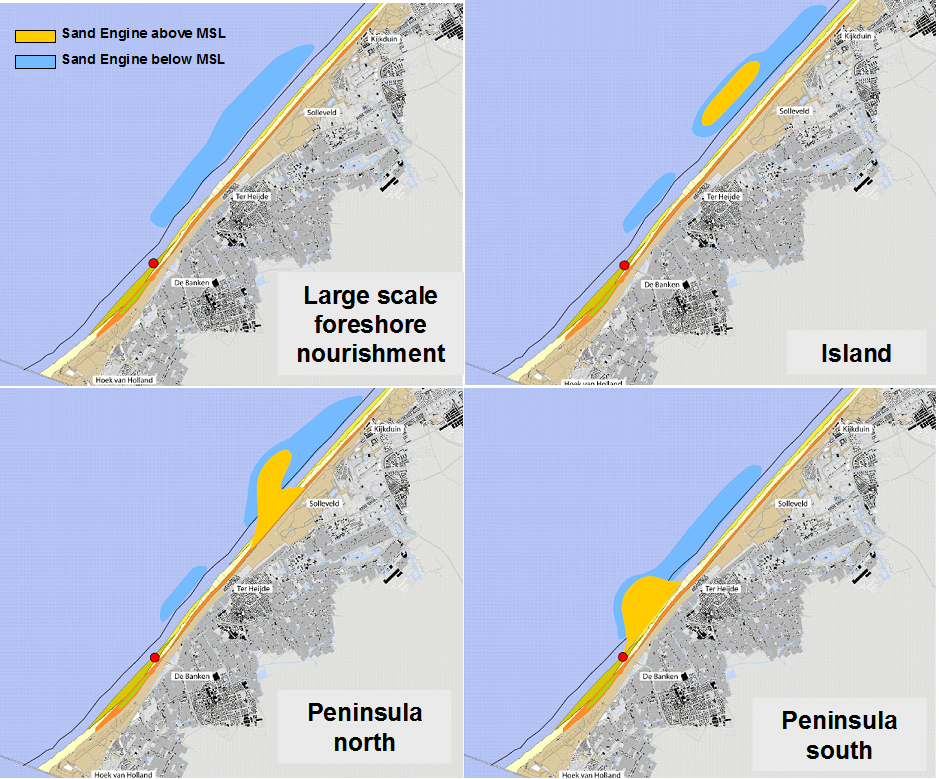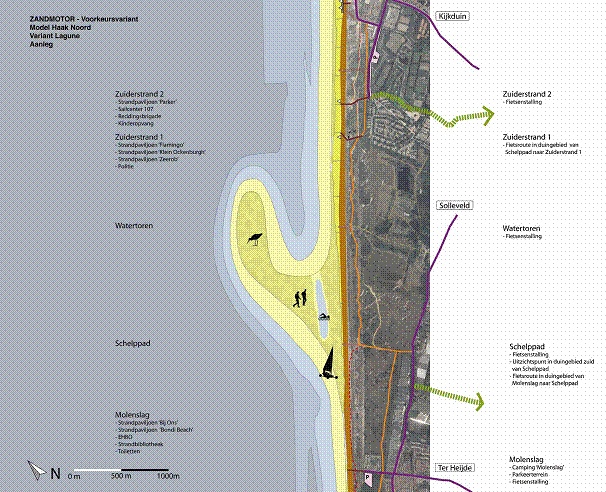Planning and design
The planning and design phase consisted of a pre-feasibility study after which the planing phase stated, taking into account the process of Environmental Impact Assessment (EIA), which emphasized on safety, recreation and knowledge development for the different scenarios.
Exploration
The Province of South Holland led the exploration phase of the Sand Motor. In a pre-feasibility study (Bruens et al, 2007) different shapes and locations of a Sand Motor were proposed and investigated. Consultant Royal Haskoning was hired to guide the process towards an ambition agreement between the main actors and to design a project development process. In April 2008 the ambition agreement was signed and the planning phase started.

Planning phase
The planning phase included the Environmental Impact Assessment (EIA) process. A strategic impact assessment (Grontmij, 2008) and an Environmental Impact Assessment (DHV, 2009) were carried out. In preparation, several alternative designs of a Sand Motor were studied and several scenarios for sustainable long-term nourishment strategies evaluated (Mulder et al., 2010). The EIA procedure was meant to identify the most feasible and environmentally friendly alternatives of nourishment-based coastal management.
Four alternatives were considered, each with a construction volume of 20 million m3 of sand:
- the original nourishment regime (4 to 5 year frequency) with larger amounts of sand,
- a large foreshore nourishment,
- a detached island 1 km off the coast, and
- a peninsula (different locations and shape) attached to the coast.

The design challenge was to locate and design a cost-effective mega nourishment that would serve coastal management and long-term coastal protection and offer opportunities to nature and recreation without having negative impacts on existing nature areas and recreation. Morphological and ecological processes were studied in order to assess the costs and the impacts of these alternatives.
The peninsula had the best scores in the EIA as far as aspects such as safety, recreation and knowledge development were concerned. The shape of a shore-attached hook gives more variation than an island or a foreshore nourishment, as a sheltered zone is created between the hook and the beach which is likely to develop into a temporary lagoon.
Several locations were considered for the peninsula. Given the nature of the pilot, the dynamic character of the Sand Motor and the existing functions and infrastructures, the Solleveld reach (between Kijkduin and Ter Heijde) was selected.
At this location the Sand Motor would have a limited (direct) effect on areas with extensive recreational functions, whereas the area is still accessible for recreation and is “central enough” to supply sediment to most of the Delfland Coast.
The Sand Motor is a pilot project. It is the first mega-nourishment of this size and form, with an anticipated functional lifespan of more than 20 years. So far the coast was maintained with periodic nourishment parallel to the coast or on the beach, the peninsula-shape is a novelty. The largest periodic nourishments are in the order of 5 to 7 million m3, with a functional lifespan of 5 to at the most 10 years.
Since form, location and volume of the Sand Motor are determined by its functioning in the first 20 years after construction, extensive morphological studies were conducted in order to underpin the initial design, realizing that long-term predictions include a large uncertainty bandwidth. Several aspects critical to beach safety, such as beach development and rip current formation, were handled with smaller-scale morphological models. Issues that could not be predicted or dealt with in the design were included in management and monitoring programmes.
Tender request
After the location and volume were determined in the EIA process, the Sand Motor was contracted with a set maximum budget. The Design and Construct contract was awarded to the contractor that could deliver the largest volume of sand for the set price.
Governance
Knowledge development in the design phase of the Sand Motor experiment focuses on three different activities: design development, design assessment to select the preferred alternative and the optimization of the preferred design. Integrating design and assessment activities led to a multifunctional design contributing to coastal safety, nature, recreation and knowledge development.
Important enabling factors for realization of the Sand Motor in the planning phase turned out to be:
- Involvement of a broad representation of actors and stakeholders in the project organization. The ambition agreement was signed by the Province, national ministries, municipalities, a environmental NGO and the Delfland Waterboard. In the project team these parties are represented and complemented with consultants and knowledge institutes (Deltares), NGOs and other parties relevant to the process. This broad and intensive involvement of actors and stakeholders turned out to positively influence the general support for the project.
- The design alternatives for the Sand Motor resulted from the pre-feasibility study (Bruens et al, 2007) and three design workshops held in the summer of 2008. In the study as well as the workshops experts from several disciplines were involved: morphologists, ecologists and dredging operation specialist. During the workshops all stakeholders were represented. This integral approach was instrumental to achieving the necessary multi-functional design.
- The location of the Sand Motor was subject to few legal restrictions, the only one being that the environment should not be negatively affected. Moreover, there were no immediate coastal safety issues and no specific targets concerning nature or recreation. The open formulation of the goals and the absence of legal restrictions contributed to feasibility of the experiment.
Next video, Dutch spoken, illustrates the predicted coastal- and potential ecological development of the Sand Motor as presented at the end of the design stage.
